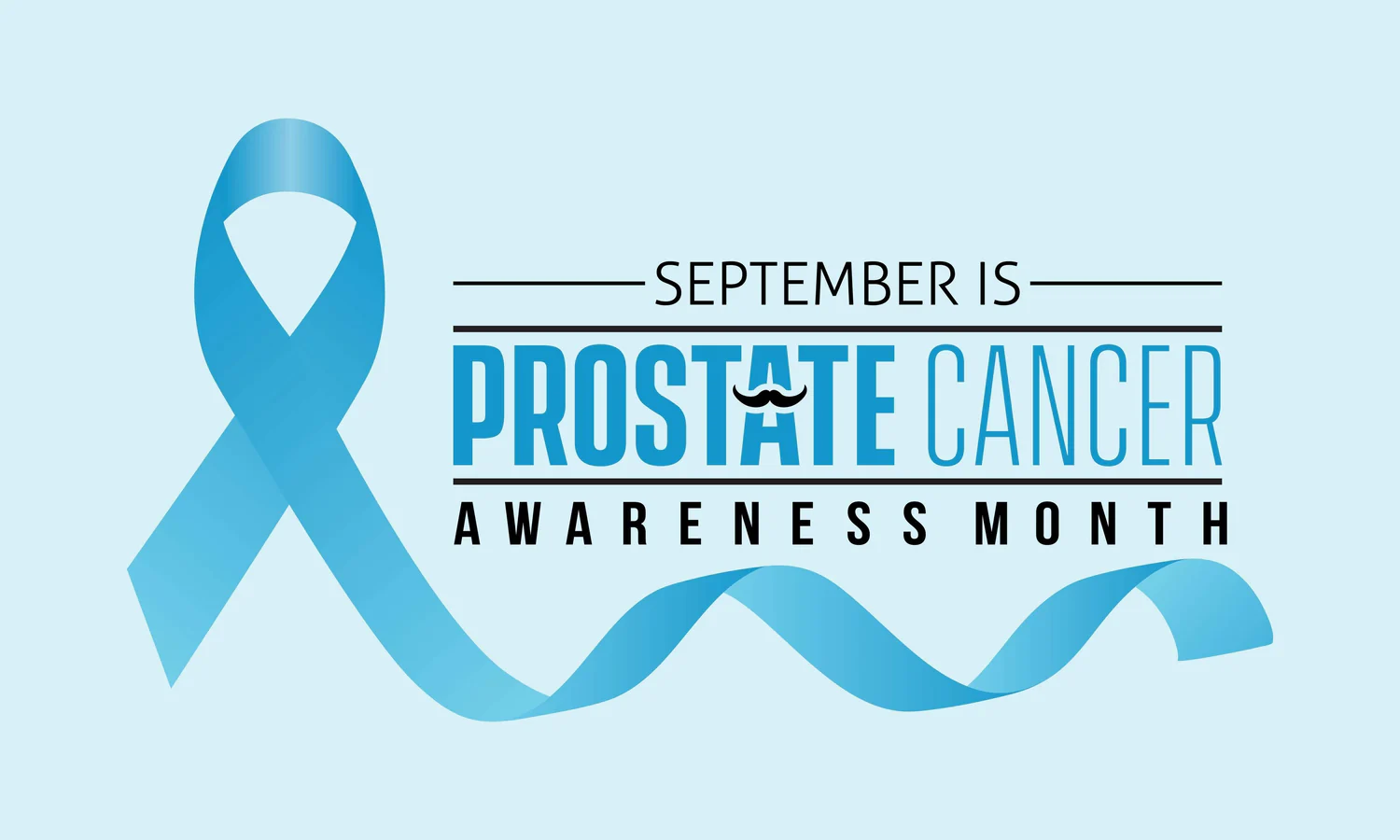Prostate Cancer Awareness
Prostate cancer is the most common cancer among men in the United States after skin cancer. According to the American Cancer Society, about 1 in 8 men will be diagnosed with prostate cancer during their lifetime[1]. The disease occurs mainly in older men and in African Americans. Fortunately, the prognosis is good when prostate cancer is detected and treated early.
Raising awareness about prostate cancer risk factors, symptoms, screening, and treatment is critical to helping men make informed decisions about their health.
This article provides an overview of key aspects of prostate cancer to empower men with knowledge about this disease.

Risk Factors
Understanding the key factors that can increase a man’s risk of developing prostate cancer is crucial. Let’s take a closer look at these risk factors:
Age
Age plays a significant role in prostate cancer risk[2]. The older a man gets, the higher the chance of developing this cancer. Shockingly, approximately 6 out of every 10 cases of prostate cancer are diagnosed in men aged 65 years or older.
Family History
Family history is another critical factor to consider[3]. If a man has a father or brother who has had prostate cancer, his own risk more than doubles. This risk becomes even more substantial if multiple family members have been affected, especially if they were relatively young when diagnosed.
Race/Ethnicity
Prostate cancer’s prevalence varies among different racial and ethnic groups[4]. African American men and Caribbean men of African descent have a higher likelihood of developing prostate cancer compared to men from other racial backgrounds. However, the reasons behind these disparities are not yet fully understood.
Gene Changes
Certain genetic changes can also raise the risk of prostate cancer[5]. Genes like BRCA1 and BRCA2 are known to be associated with an increased risk. Additionally, men with Lynch syndrome, also known as hereditary nonpolyposis colorectal cancer (HNPCC), face an elevated risk as well[6].
Obesity
Obesity is another factor that may impact prostate cancer risk[7]. Obese men who are diagnosed with prostate cancer may be more likely to have an advanced form of the disease that is more challenging to treat. Maintaining a healthy weight can be essential in reducing this risk.
By understanding these risk factors, individuals and healthcare professionals can make informed decisions and take appropriate steps to manage and reduce the risk of prostate cancer.
Symptoms
Early prostate cancer often has no symptoms. Some advanced prostate cancers cause symptoms like:
- Frequent or difficult urination
- Weak or interrupted urine flow
- Pain or burning during urination
- Blood in the urine or semen
- Pain in the back, hips, chest, or other areas from cancer spread
Noncancerous conditions like benign prostatic hyperplasia (BPH) cause similar symptoms. Urinary symptoms are not specific to prostate cancer but should be reported to a doctor.

Screening
There are two main screening tests for prostate cancer:
Digital Rectal Exam (DRE)
A doctor inserts a gloved, lubricated finger into the rectum to feel the prostate for bumps or other abnormalities. DRE is easy to do but limited in its ability to detect small tumors[8].
Prostate-Specific Antigen (PSA) Blood Test
PSA is a protein made by the prostate. High levels may indicate cancer but can also be caused by noncancerous prostate conditions. The PSA test is controversial due to the risks of overdiagnosis and overtreatment[9].
Several organizations have different recommendations for PSA screening. Most advise men to talk with their doctor about their individual risk factors and make an informed decision.
Diagnosis
If screening reveals potential prostate cancer, doctors use tests like:
- Transrectal ultrasound – Sound waves create images of the prostate
- Biopsy – Small tissue samples are examined for cancer cells
If cancer is found, further tests determine if/where it has spread (metastasized) beyond the prostate. This helps determine the stage of the cancer.
Treatment
Treatment for prostate cancer varies depending on factors such as the cancer’s stage, grade, and the overall health of the patient. Here are some treatment options, along with explanations and their potential side effects:
Active Surveillance
Active Surveillance is a treatment approach where doctors closely monitor the patient’s condition without immediately starting any treatment for prostate cancer[10]. The goal here is to avoid unnecessary treatments that could have side effects.
Instead, doctors keep a close eye on the cancer’s behavior, and if it starts to progress, they can consider other treatment options.
Surgery
Surgery involves the removal of the prostate gland, the organ where the cancer is located[11]. This is done to physically eliminate the cancer cells.
However, surgery can have side effects, including problems with urination or difficulties with achieving and maintaining erections. These side effects can impact a man’s quality of life.
Radiation Therapy
Radiation therapy uses high-energy beams to target and kill cancer cells in the prostate[12]. The radiation damages the DNA of the cancer cells, preventing them from growing.
Side effects can include problems with the bowel, bladder, and erections. Radiation therapy is a localized treatment, meaning it mainly affects the area where the radiation is directed.
Hormone Therapy
Hormone therapy is a treatment that aims to block the hormones, such as testosterone, that can fuel the growth of prostate cancer[13]. By reducing the levels of these hormones, doctors hope to slow down or stop the cancer’s progression.
However, hormone therapy can come with side effects like hot flashes, erectile dysfunction (difficulty achieving or maintaining erections), and a loss of bone and muscle mass over time.
Chemotherapy
Chemotherapy uses powerful drugs to kill cancer cells throughout the body[14]. It may be used in combination with other treatments or when prostate cancer has spread to other parts of the body.
Chemotherapy can have various side effects, such as nausea, hair loss, fatigue, and lowered resistance to infections. It is typically considered when other treatments are no longer effective.
Immunotherapy
Immunotherapy is an emerging approach that helps the body’s immune system recognize and attack cancer cells[15]. This treatment aims to enhance the body’s natural defenses against cancer.
Immunotherapy is considered a promising option, especially for advanced prostate cancer cases. It can have side effects, including immune-related reactions like skin rashes or gastrointestinal issues.
The choice of treatment depends on several factors, including the stage and grade of the cancer, as well as the patient’s overall health. Doctors will consider these factors carefully to determine the best course of action for achieving long-term remission and survival while minimizing the impact of potential side effects on the patient’s quality of life.
Prevention
Research continues on identifying risk factors and how to prevent prostate cancer. Current recommendations include:
- Eating a healthy diet high in fruits/vegetables
- Exercising regularly
- Achieving and maintaining a healthy weight
- Discussing the pros/cons of screening with your doctor
- Making lifestyle changes to reduce risk factors within your control

Conclusion
As one of the most common cancers in men, prostate cancer deserves serious attention. Knowing the risks, getting screened appropriately, recognizing possible symptoms, and understanding treatment options gives men the power to be proactive about prostate health.
Increased awareness and open communication with doctors can help detect prostate cancer early when outcomes are best. While more research is still needed, men can take charge of their health by making positive lifestyle choices and advocating for their well-being.
References
- American Cancer Society. (2022). Key statistics for prostate cancer.
https://www.cancer.org/cancer/prostate-cancer/about/key-statistics.html
- National Cancer Institute. (2022). Prostate cancer risk factors.
https://www.cancer.gov/types/prostate/patient/prostate-prevention-pdq#_1 - Cheng I, Witte JS, Jacobsen SJ, et al. (2011). Prostatitis, sexually transmitted diseases, and prostate cancer: the California Men’s Health Study. PLOS One, 5(1), e8736. https://doi.org/10.1371/journal.pone.0008736
- American Cancer Society. (2019). Prostate cancer risk factors.
https://www.cancer.org/cancer/prostate-cancer/causes-risks-prevention/risk-factors.html - National Cancer Institute. (n.d.). BRCA1 and BRCA2: Cancer risk and genetic testing.
https://www.cancer.gov/about-cancer/causes-prevention/genetics/brca-fact-sheet - Win AK, Lindor NM, Young JP, et al. (2012). Risks of primary extracolonic cancers following colorectal cancer in Lynch syndrome. J Natl Cancer Inst, 104(18), 1363-1372.
https://doi.org/10.1093/jnci/djs351
- Allott, Emma H et al. “Obesity and prostate cancer: weighing the evidence.” European urology vol. 63,5 (2013): 800-9. doi:10.1016/j.eururo.2012.11.013
- Carter HB, Albertsen PC, Barry MJ, et al. (2013). Early detection of prostate cancer: AUA Guideline. J Urol, 190(2), 419-426. https://doi.org/10.1016/j.juro.2013.04.119
- Moyer VA and U.S. Preventive Services Task Force. (2012). Screening for prostate cancer: U.S. Preventive Services Task Force recommendation statement. Ann Intern Med, 157(2), 120-134.
https://doi.org/10.7326/0003-4819-157-2-201207170-00459 - Tosoian, Jeffrey J et al. “Intermediate and Longer-Term Outcomes From a Prospective Active-Surveillance Program for Favorable-Risk Prostate Cancer.” Journal of clinical oncology : official journal of the American Society of Clinical Oncology vol. 33,30 (2015): 3379-85. doi:10.1200/JCO.2015.62.5764
- Barocas DA, Alvarez J, Resnick MJ, et al. (2017). Association between radiation therapy, surgery, or observation for localized prostate cancer and patient-reported outcomes after 3 years. JAMA, 317(11), 1126-1140. https://doi.org/10.1001/jama.2017.1704
- National Cancer Institute. (n.d.). Prostate cancer treatment (PDQ)–Health professional version: Radiation therapy.
https://www.cancer.gov/types/prostate/hp/prostate-treatment-pdq#_1_6 - Hussain M, Tangen CM, Higano C, Schelhammer PF, Faulkner J, Crawford ED, Wilding G, Akdas A, Small EJ, Donnelly B, MacVicar G, Raghavan D. (2006). Absolute prostate-specific antigen value after androgen deprivation is a strong independent predictor of survival in new metastatic prostate cancer: data from Southwest Oncology Group Trial 9346 (INT-0162). J Clin Oncol, 24(24), 3984-3990.
https://doi.org/10.1200/JCO.2006.06.4246 - Sweeney CJ, Chen YH, Carducci M, et al. (2015). Chemohormonal therapy in metastatic hormone-sensitive prostate cancer. N Engl J Med, 373(8), 737-746.
https://doi.org/10.1056/NEJMoa1503747 - National Cancer Institute. (n.d.). Prostate cancer treatment (PDQ)–Health professional version: Immunotherapy.
https://www.cancer.gov/types/prostate/hp/prostate-treatment-pdq#_1_8







